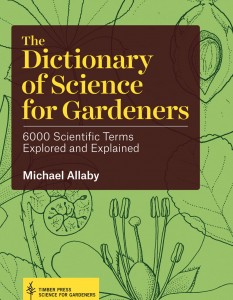Book Review: The Dictionary of Science for Gardeners
Posted in From the Library, Horticulture, Shop/Book Reviews on March 16 2016, by Esther Jackson
Esther Jackson is the Public Services Librarian at NYBG’s LuEsther T. Mertz Library where she manages Reference and Circulation services and oversees the Plant Information Office. She spends much of her time assisting researchers, providing instruction related to library resources, and collaborating with NYBG staff on various projects related to Garden initiatives and events.
 The Dictionary of Science for Gardeners by Michael Allaby clocks in at 553 pages and 6,000 scientific terms. Upon first learning about this publication, I was intrigued. Reading the introduction, I became even more fascinated. Allaby has written, edited, or co-authored over 100 books on environmental science. Prior to writing The Dictionary of Science for Gardeners, he edited four other scientific dictionaries for Oxford University Press. He also has an absolutely delightful personal website from which the following quote is taken—“Dictionaries don’t tell stories, well not really although I do my best even with them. I compile dictionaries, you see…Oh yes, I do dictionaries. Want a dictionary? I’m your man.”
The Dictionary of Science for Gardeners by Michael Allaby clocks in at 553 pages and 6,000 scientific terms. Upon first learning about this publication, I was intrigued. Reading the introduction, I became even more fascinated. Allaby has written, edited, or co-authored over 100 books on environmental science. Prior to writing The Dictionary of Science for Gardeners, he edited four other scientific dictionaries for Oxford University Press. He also has an absolutely delightful personal website from which the following quote is taken—“Dictionaries don’t tell stories, well not really although I do my best even with them. I compile dictionaries, you see…Oh yes, I do dictionaries. Want a dictionary? I’m your man.”
The Dictionary of Science for Gardeners covers 16 branches of science relevant to gardeners as determined by Allaby and includes “plant classification, the science of how and why plants are grouped into genera and families, plant geography or how the world breaks down floristically, plant evolution, with the genetic code as an appendix, plant structure and function, or how plants work, fungi, insects, other invertebrate animals, vertebrate animals, bacteria and viruses, the way major nutrients move through cycles, pesticides, soil science including the way soils are classified, ecology, conservation, and weather and climate.” It is interesting to see the branches of botany so defined, and a good indication as to how The Dictionary is written in order for a wide array of scientific terminology to be accessible to readers, including scientific names of birds and bugs that might be seen in a garden.
The Dictionary of Science for Gardeners includes limited illustrations, and readers would do well to supplement this publication with Plant Identification Terminology: An Illustrated Glossary or a similar illustrated glossary. By way of supplemental material, The Dictionary includes a list of websites for further reading and more detailed information about certain terms. Words with corresponding websites are indicated with a symbol alongside their definition. When definitions include words that themselves have definitions, those words are bolded. For the dictionary and thesaurus enthusiasts, there are numerous and consistently applied “see” and “see also” notes.
Flipping through the pages, an eclectic mix of words jump out. Guiacum officinale, guild, gully, gum, gum duct, gummosis, Gumuia, and Gunneraceae are terms defined in the second column on page 236. A reader might learn that hysiginous means “red in colour” (Allaby hails from Scotland) and villous means “covered with soft, unmatted hairs.” Allaby has a knack for defining scientific terms succinctly, and the use of bolded words to refer readers to additional terms makes teasing apart a challenging definition much easier.
With 6,000 terms,The Dictionary can’t be comprehensive in any one area. Even so, at $40 with a portable size and weight—relative to other dictionaries—it is a great addition to a plant lover’s library. With its breadth of information, The Dictionary of Science for Gardeners is a valuable resource for gardeners, horticulturists, new botany students, and dictionary lovers everywhere.

